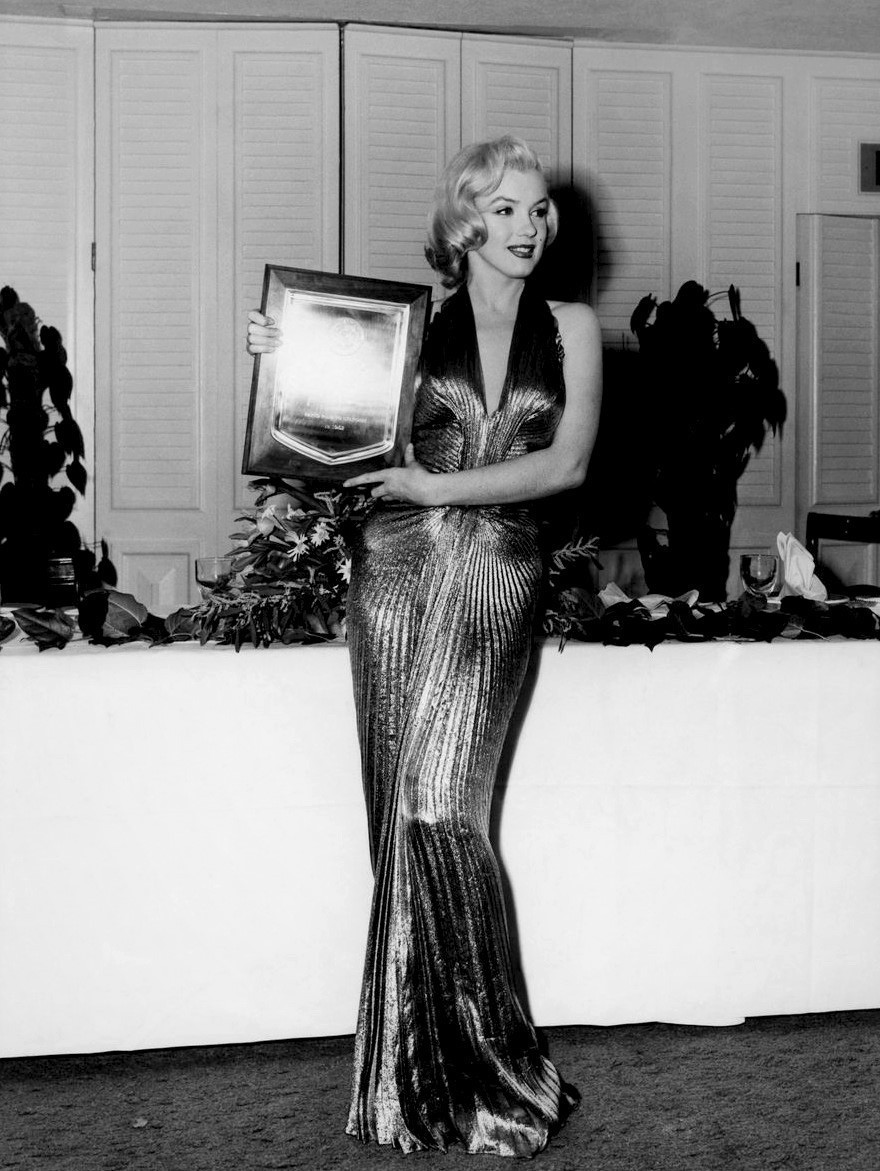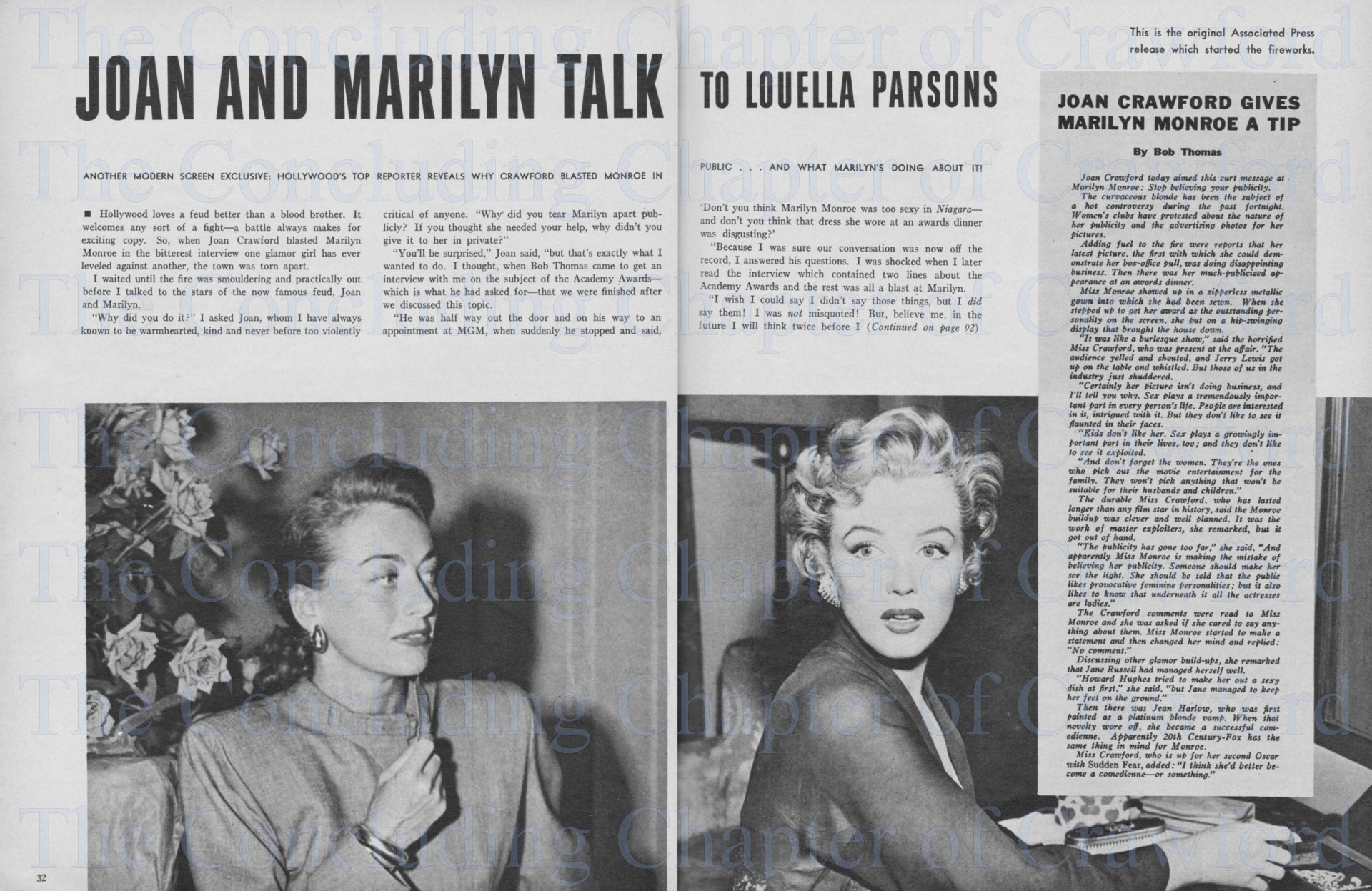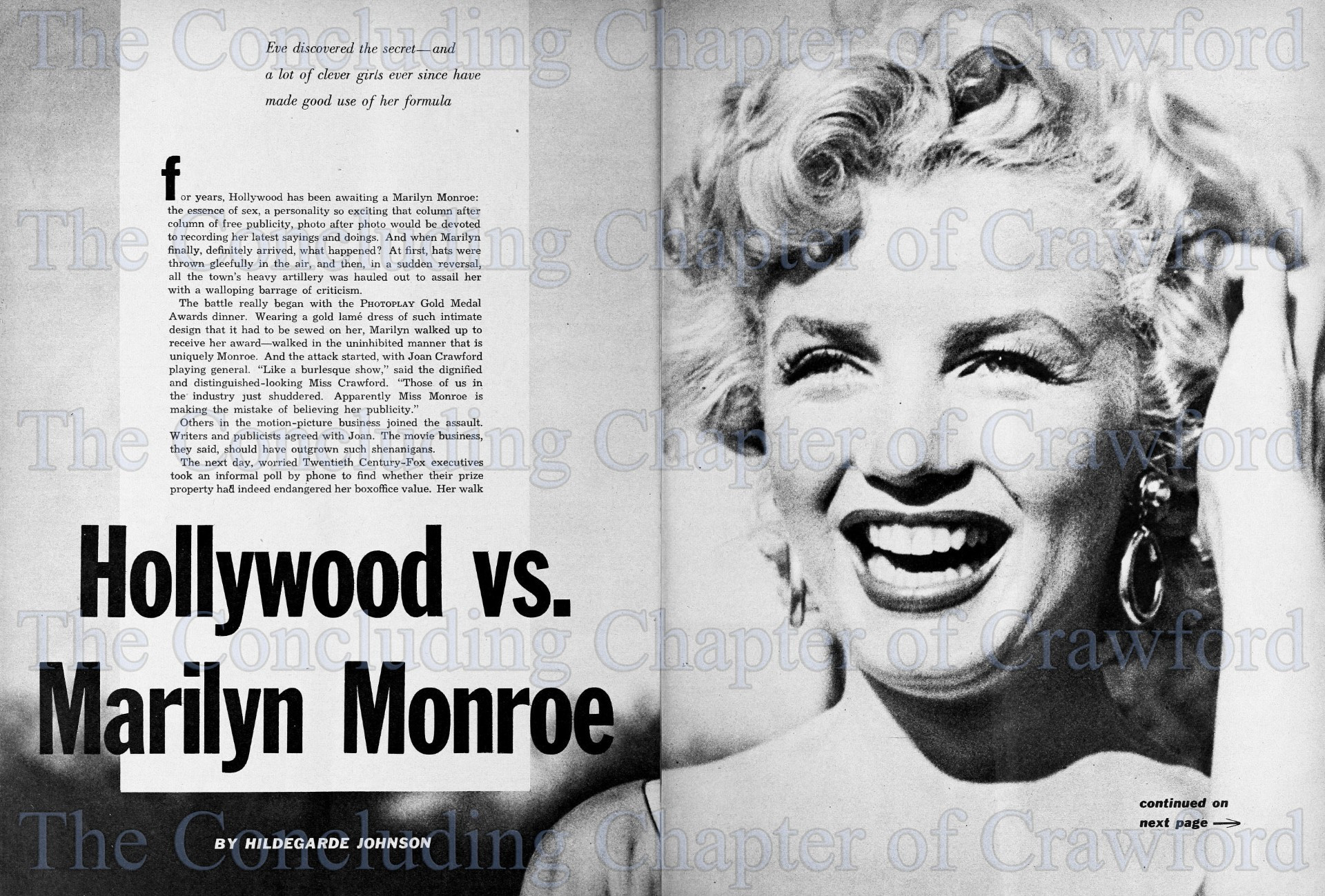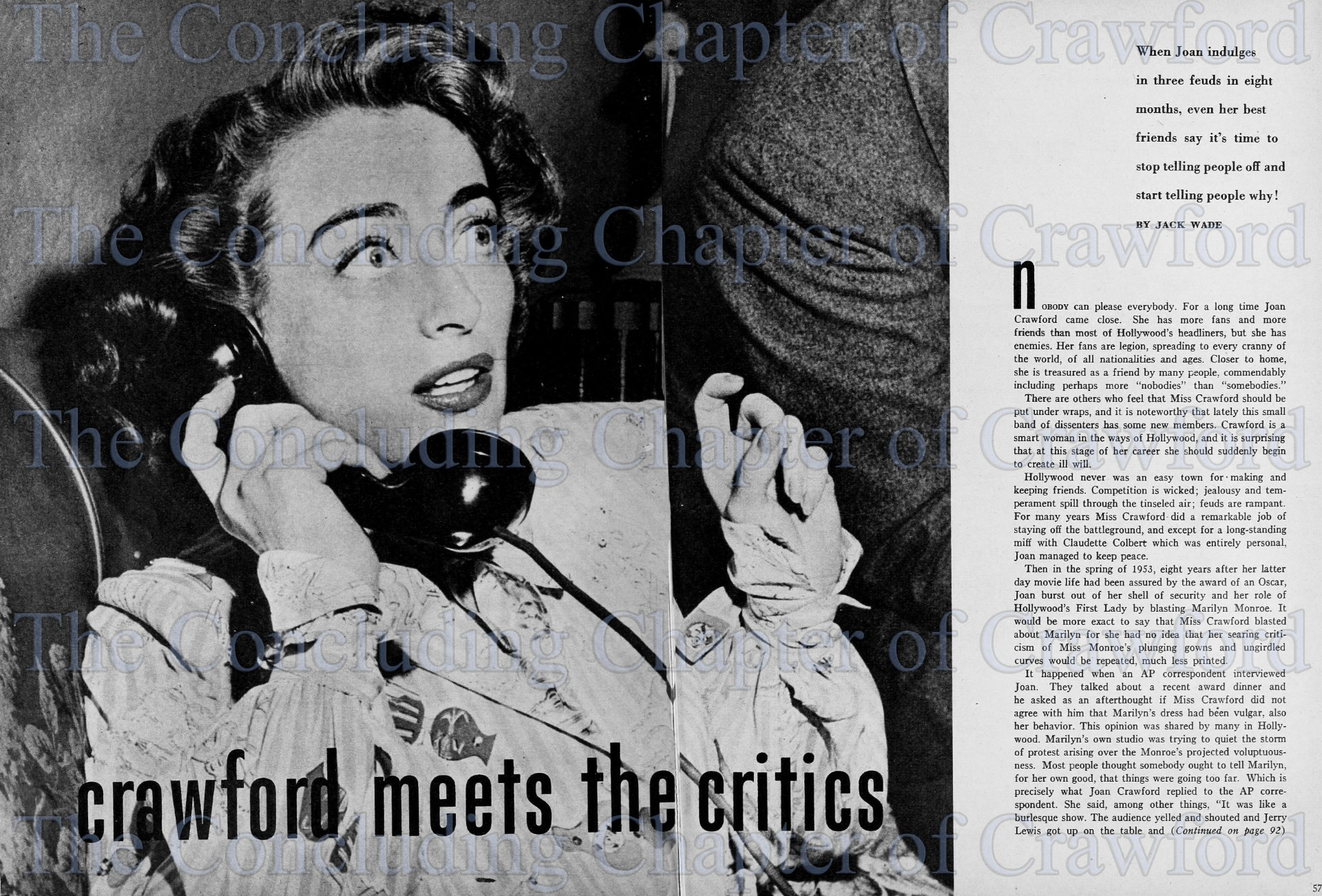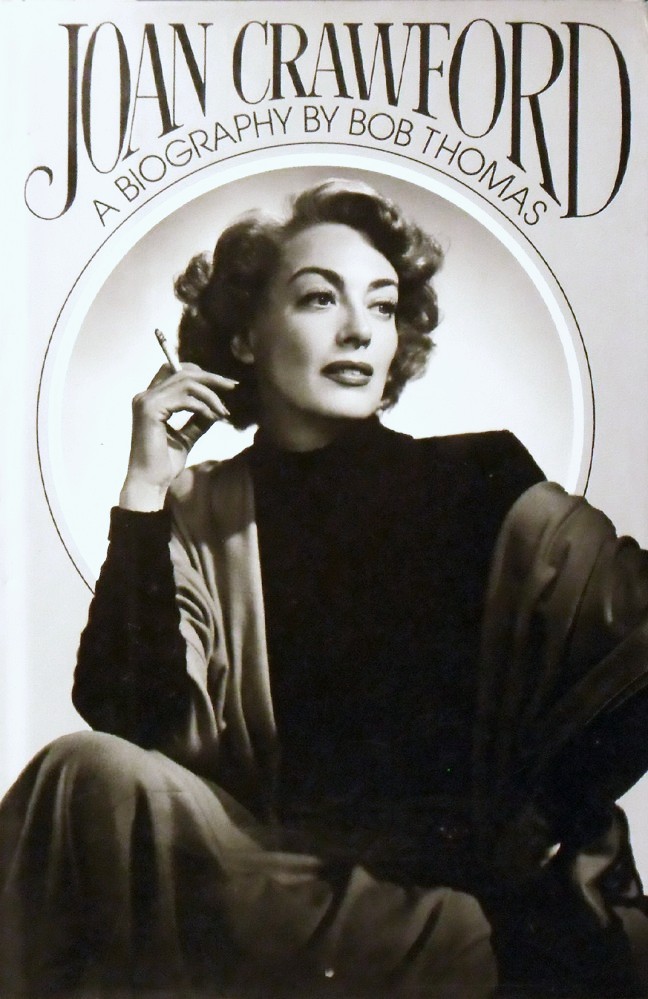Debunking Joan Crawford and Marilyn Monroe's "Feud"
Did Joan Crawford and Marilyn Monroe have a "feud"? The answer is: No
The Origin of the Joan Crawford and Marilyn Monroe "Feud" Rumor
The alleged "feud" between Joan and Marilyn Monroe originated due to a March 2nd, 1953 article by Associated Press journalist Bob Thomas, who published off-the-record comments Joan made to him regarding Monroe's recent appearance at an awards dinner.
On February 9th, 1953, Joan Crawford and Marilyn Monroe were among the guests who attended the 1952 Photoplay Gold Medal Awards dinner, held in the Crystal Room at the Beverly Hills Hotel. The press claimed that Marilyn Monroe entered the dinner one and a half hours late in a skintight gold lamé dress. Everyone, including Joan, immediately focused their attention on Monroe. Later, when Monroe accept her award for " The Outstanding New Personality On The Screen," she reportedly swung her hips while walking to the podium, enticing many male guests to shout and whistle.
According to the various reports, Joan was jealous and angry that Monroe had garnered such attention. However, according to the multiple news articles many guests at the dinner were upset with Monroe's tardiness, inappropriate behavior and provocative appearance. So, how is it that only Joan's response stood out?
In the weeks following the Photoplay awards ceremony, 30-year-old Bob Thomas was in the midst of writing an article detailing the recent outrage by the Women's Club of Hollywood towards Monroe's provocative wardrobe. According to Thomas, he interviewed Joan at the Polo Lounge at the Beverly Hills Hotel on February 12th in regard to her recent "Best Actress" Academy Award nomination for "Sudden Fear." According to Joan, at the conclusion of Thomas's interview with her, he was leaving her dressing room when he asked her what she thought about Monroe's appearance at the Photoplay Awards ceremony. Joan assumed their interview was officially over, and thought Thomas was making off-the-record small talk. Joan told Thomas "it was like a burlesque show." Thomas told Joan his own criticizing comments regarding Monroe, to which Joan agreed, thinking her comments and agreed opinion were only between the two of them. However, unethically, Thomas published Joan's remarks in his nationally syndicated article.
March 2nd, 1953 Bob Thomas, Associated Press:
"Joan Crawford Monday aimed this curt message at Marilyn Monroe: Stop believing your publicity.
The curvaceous blond has been the subject of a hot controversy during the past fortnight. Women’s clubs have protested about the nature of her publicity and the advertising photos for her pictures. When I addressed the woman’s Club of Hollywood a week ago, the members were eager to know what the producers were doing to curb Miss Monroe.
Adding fuel to the fire were reports that her latest picture, the first with which she could demonstrate her box-office pull, was doing disappointing business. Then there was her much-publicized appearance at the Photoplay awards dinner.
Miss Monroe showed up in a zipperless metallic gown into which she had to be sewn. When she stepped up to get her award as the outstanding new personality on the screen, she put on a hip-swinging display that brought the house down.
“I was like a burlesque show,” said the horrified Miss Crawford, who was present at the affair. “The audience yelled and shouted, and Jerry Lewis got up on the table and whistled. But those of us in the industry just shuddered."
“Certainly her picture isn’t doing business, and I’ll tell you why. Sex plays a tremendously important part in every persona’s life. People are interested in it, intrigued with it. But they don’t like to see it flaunted in their faces."
“Kids don’t like her. Sex plays a growingly important part in their lives, too, and they don’t like to see it exploited.
And don’t forget the women. They’re the ones who pick out the movie entertainment for the family. They won’t pick anything that won’t be suitable for their husbands and children.”
The durable Miss Crawford, who has lasted longer than any other film star in history, said the Monroe buildup was clever and well planned.
It was the work of master exploiters, she remarked, but it got out of hand.
“The publicity has gone too far.” she said. “And apparently Miss Monroe is making the mistake of believing her publicity. Someone should be told that the public likes provocative feminine personalities; but it also likes to know that underneath it all the actresses are ladies.
The Crawford comments were read to Miss Monroe and she was asked if she cared to say anything about them. Miss Monroe started to make a statement and then changed her mind and replied: “No comment.”
Discussing other glamour buildups, she remarked that Jane Russell had managed herself well.
“Howard Hughes tried to make her out a sexy dish at first,” she said, “but Jane managed to keep her feet on the ground.”
Then there was Jean Harlow, who was first painted as a platinum blond vamp. When that novelty wore off, she turned redhead and became a successful comedienne. Apparently 20th-Fox has the same thing in mind for Monroe. Although she wants to be a dramatic actress, the studio is grooming her for comedies like “Gentlemen Prefer Blonds.”
Miss Crawford, who is up for her second Oscar with “Sudden Fear,” added: “I think she’d better become a comedienne – or something.”
I think Miss Monroe also believes it’s time for a change. Her performance in last week’s Redbook dinner was far different from the Photoplay event. Again chosen as the outstanding young personality, she showed up in a conservative for her black cocktail dress.
When “Martin and Lewis” urged her to come up to the microphone, she declined until three of her advisers urged her to do so. Then she walked quietly up and expressed her thanks in a small, frightened voice.”
Following the publication of Joan's comments, she did not deny that she said them, she admitted to it. However, she explained that she thought these comments were off-the-record, and that she did not think they would be published in Thomas's article. However, the article set about a media firestorm, with the press generating a manufactured "feud" between Joan and Monroe.
Associated Press journalist Bob Thomas with Marilyn Monroe
Bob Thomas's 1978 Joan Crawford Biography
Prior to Joan's comments in Bob Thomas' article, she had not been the first person in Hollywood to criticize Monroe or her wardrobe. In fact, many journalists and other actors had openly ridiculed Monroe and heckled her sultry appearance. Below is a sampling of such published criticisms.
Bob Thomas' March 2nd, 1953 article on Monroe with Joan's comments
Erskine Johnson's February 9th, 1953 press mention about Monroe's Levi blue jeans
Sheilah Graham's February 16th, 1953 press mention about Monroe's Photoplay Awards dress, along with a mention of Joan
Sheilah Graham's February 14th, 1953 press mention about Monroe's actions at the Photoplay Awards and her provocative "walk" in "Niagara"
An Associated Press column dated March 1st, 1953 quoting actress Marie Windsor regarding Monroe
If I may regress to the beginning of this situation, I would like to call your attention back to Bob Thomas, and in particular, to and an article he published on February 14th, 1953. Within this article, Thomas criticized Monroe and the lack of public interest for "Niagara." This article by Thomas was a mere two weeks before his article featuring Joan's comments on Monroe.
Additionally, within this same February 14th article, Thomas complains that reporters go unappreciated for their coverage of award ceremonies, and specifically names the recent Photoplay Gold Medal Awards dinner.
April 14th, 1953 Bob Thomas, Associated Press:
"Within a few days, I covered the TV Academy awards, the Movie Academy nominations and the Photoplay award dinners. Also currently in season are the award events of the Screen Directors Guild, Screen Writers Guild, Redbook, Look, Pic and Click. Surely a reporter deserves some kind of award for getting through all of them.
...Marilyn Monroe received a citation as the fastest rising star at the Photoplay dinner. yet Variety lists her latest movie, "Niagara," as doing NSH business in Los Angeles. That means "not so hot." How come? Maybe Marilyn is hot in the papers and mags, but NSH at the box office as yet. Or maybe the ladies, who usually dictate what movies the family attends, don't wanna see her. Just saying maybe, that's all."
I would like to call your attention to how similar Thomas' February 14th article comments on Monroe are in comparison to Joan's comments on Monroe that Thomas published on March 2nd. Particularly the comments regarding "Niagara" and about women picking the family's entertainment.
A refresher on Joan's comments in Thomas' article:
“Certainly her picture isn’t doing business, and I’ll tell you why. Sex plays a tremendously important part in every persona’s life. People are interested in it, intrigued with it. But they don’t like to see it flaunted in their faces....And don’t forget the women. They’re the ones who pick out the movie entertainment for the family. They won’t pick anything that won’t be suitable for their husbands and children.”
I am not claiming that Joan did not make these criticisms of Monroe. Joan admitted to stating these comments. However, based upon these parallel statements that were made by two different people, published in two different articles, however, written by the same writer, an observer may come to the conclusion that Thomas purposely introduced these topics during his conversation to Joan as a form of planned entrapment.
Bob Thomas' February 14th, 1953 article for the Associated Press
Marilyn Monroe at the 1952 Photoplay Gold Medal Awards dinner, February 9th, 1953
Joan and Monroe's Responses To Bob Thomas' Article
In response to Bob Thomas' article, Joan and Monroe were interviewed for an article published in the July 1953 issue of "Modern Screen" magazine.
In the article, Joan and Monroe gives their sides of the story to Louella Parsons regarding Thomas' article.
Modern Screen July 1953:
"Hollywood loves a feud better than a blood brother. It welcomes any sort of a fight - a battle always makes for exciting copy. So, when Joan Crawford blasted Marilyn Monroe in the bitterest interview one glamour girl has ever leveled against another, the town was torn apart.
I waited until the fire was smoldering and practically out before I talked to the stars of the now famous feud, Joan and Marilyn.
"Why did you do it"? I asked Joan, whom I have always known to be warmhearted, kind and never before too violently critical of anyone. "Why did you tear Marilyn apart publicly? If you thought she needed your help, why didn't you give it to her in private?
"You'll be surprised," Joan said, "but that's exactly what I wanted to do. I thought, when Bob Thomas came to get an interview with me on the subject of the Academy Awards - which is what he had asked for - that we were finished after we discussed this topic. He was half way out the door and on his way to an appointment at MGM, when suddenly he stopped and said, "Don't you think Marilyn Monroe was too sexy in "Niagara" - and don't you think that dress she wore at the awards dinner was disgusting?"
"Because I was sure our conversation was now off the record, I answered his questions. I was shocked when I later read the interview which contained two lines about the Academy Awards and the rest was all a blast at Marilyn. I wish I could say I didn't say those things, but I did say them! I was not misquoted! But, believe me, in the future I will think twice before I talk so openly!"
There was so much honesty in what Joan said and so much distress in her voice that I reached over and patted her hand. We were sitting in a quiet corner, away from the other guests at a small dinner party at my home. Dinner was over - and I knew Joan wanted to talk to me. And you can bet I wanted to talk to her!
When the others started talking or gathering around the piano to sing, I motioned for Joan to join me away from the group. (I think most of them would have given anything to have heard what we were saying for the Crawford vs. Monroe feud was still the talk of the town.)
Joan and I have been friends for many years now and I feel I understand her very well. I sincerely believe she would give anything in the world if she never said those things about Marilyn. But, once the damage was done, you've got to admire her spunk for saying she was not misquoted!
She was in the firing line - but she was standing there taking it - and saying she was sorry! You've got to admire a girl like that.
Joan leaned toward me and said softly, "There's still room in this town for both of us. I feel if I were to meet Marilyn face to face I'd say, "Hi there," - and we'd shake hands."
"Louella, just one more thing. I do want Marilyn to know how bitterly sorry I am that this interview was ever printed. But for this thing to go on and on, as though someone had been murdered, is ridiculous."
We now lap-dissolve (as they say in the movie scripts) back to a conversation I had with Marilyn the day after Joan's blistering interview hit the press. She had been crying her eyes out all night. Her voice was so choked up she sounded as though she had a terrible cold.
"I don't believe Miss Crawford said those things about me," she whispered. "Everyone's calling, calling, calling, to see what I have to say. What shall I do?"
"Say "No comment" to everything - and then you can't get in trouble," I advised my little blond friend. But three weeks later, with letters from the fans pouring it, I called Marilyn again and told her I thought the time had come for her to say something. The intervening weeks had calmed Marilyn down to a noticeable degree. This time she really had a bad cold and she had been out of the hospital just 24 hours when she dropped by my house in the afternoon...After we had chatted a minute about this and that, she got to the point.
"Miss Parsons, I don't want to feud with anyone. All I want is to get to feeling well again and get good pictures at the studio and learn to become a better actress. I think the thing that hit me the hardest about Miss Crawford's story is that it came from her. I've always admired her for being such a wonderful mother - for taking four children and giving them a fine home. Who, better than I, knows what it means to homeless little ones. Although I don't know Miss Crawford very well - I met her once at a dinner party, she was a symbol to me of kindness and understanding to those who need help.
At first all I could think of was "Why should she select me to blast?" She's a great star. I'm just starting. And then, when the first hurt began to die down, I told myself she must have spoken to Mr. Thomas impulsively, without thinking."
I told Marilyn she "expressed" herself all right because she's always honest and never tries to fool herself - or others. She knows she first attracted attention because of her sexy appearance - but she's trying as hard as she can to improve herself as an actress. For this reason, the part of Joan's article which hit her the hardest was the reference to her vulgar walk in "Niagara."
She said, "You see, the character I played was a tramp. The role called for me to wear very tight dresses and high heels. The combination of a dress I could scarcely move in and the high heels cause me to "wobble" when I walked. With all the publicity I've had and everything, I suppose it will be hard for many people to believe that I never deliberately throw my sex around, thinking, "If I do this, it's sexy - or if I look a certain way, it's sexy."
Sex has been the stepping stone to her career - and she's not knocking it! But the lowcut dresses and the dreamy-eyed photographs have served their purpose, and she's eager to go forward as a performer and as a person.
"This is why I'm gradually getting over the hurt of Miss Crawford's interview." Marilyn said just before leaving. "It's over and done with and I shan't think about it anymore. I'll just keep believing she didn't really mean all those things she said to Mr. Thomas."
And she didn't, Marilyn. Believe me."
In a May 28th, 1954 letter that Joan's secretary, and longtime friend, Betty Barker wrote to columnist Hedda Hopper, Barker stated Joan also wrote Monroe a personal letter of apology, and that Barker herself mailed it.
"Because MM [Marilyn Monroe] went a little berserk with the minus-the-underthings and plus everything else wasn't Joan's fault. After that, Joan may have said a few things off-the-record about Marilyn, but all of us are entitled to our opinions, and I think much of our opinions would look pretty nasty in print. What Joan may have said off-the-record was supposed to have been off-the-record, and the reporter who started the Monroe controversy seems to me to have been more to blame for betraying Joan's confidences. What some people think of Marilyn Monroe I hope he never hears! P.S. ask Harry Brand about the beautiful letter of apology that Joan wrote to Marilyn Monroe. I know because I mailed it."
"Joan and Marilyn Talk To Louella Parsons" - The July 1953 edition of "Modern Screen" magazine
The Media's Deception
Joan and Monroe both hoped their interviews in the Louella Parsons article that published in the July 1953 issue of "Modern Screen" would end of the rumor of their alleged "feud," and explain to the public what had actually occurred. However, the press refused to allow such a titillating story, which involved two of the world's most popular film stars, to end.
Articles degrading both Joan and Monroe, and keeping the media-generated "feud" between them alive, appeared throughout 1953.
In fact, Joan's quotes from Bob Thomas' article was still being published in magazine articles an entire year after Thomas' article had been published.
This was the case in the March 1954 "Modern Screen" article entitled "Crawford Meets The Critics."
"Hollywood Vs. Marilyn Monroe" - Photoplay magazine, July 1953
"Crawford Meets The Critics" - "Modern Screen" magazine, March 1954
The Origin of The Rumor | Crawford and Monroe's Responses | The Media's Deception | Bob Thomas' Crawford Biography
Following the fallout of Bob Thomas' Crawford/Monroe article, he attempted to mitigate the negative attention toward himself. Therefore, Thomas published an article that attempted to represent himself as somewhat of a victim of his own actions.
April 5th, 1953 Bob Thomas, The Associated Press
"The Joan Crawford-Marilyn Monroe controversy still rages. Going on eight years, I have been working the Hollywood vineyards, no story I have ever written has evoked as much fuss as the one in which Crawford lambasted Monroe for allegedly believing her own publicity. So perhaps we'd better review hoe it all happened and what has happened since.
The story was no press agent's plant. Crawford's press agent probably would have shushed her up if he had gotten the opportunity. I was lunching with Crawford, and we were discussing her new TV venture, Academy Awards and other topics. Nothing exciting had evolved, so I tossed Monroe at her. That did it. The Monroe thing had been brewing for a couple of weeks. Her picture had failed to do the business expected of it, and the women's clubs were beginning to protest about her sexy advertising and publicity. The climax came at the Photoplay dinner. Monroe showed up in one of her traffic-stopping movie gowns. When she went up to get her award, she put on a hip-waving exhibition that brought the house down. Many of the onlookers were amused. Crawford wasn't. Hence the blast.
Since the AP always gives the opportunity for both sides of a controversy to be heard, Monroe had the chance to answer Crawford's statements before they appeared in print. She declined.
When the story appeared, things started popping. Some columnists came to Monroe's defense. Most of the commentators pointed out that Crawford had a pretty racy buildup when she was a starlet in the flapper days. (But isn't that all the more reason why she should be qualified to comment?)
At least two columnists recorded a breathless moment - when Crawford and Monroe almost met at a party.
Betty Grable broke into print with a story blasting Monroe's critics. The publicity chief at Monroe's studio was reported as having given Crawford a tongue-lashing.
This week Mike Connolly of Hollywood Reporter said "somebody important" at 20th-Fox wrote Crawford: "Don't apologize to Marilyn. Your advice was good for her."
That seems to be the consensus. Her bosses at 20th-Fox were concerned about overdoing the sexy buildup and tried to persuade Monroe to tone it down. She couldn't see it that way, since the routine had made a star out of her. But now she has become much more conservative.
Monroe got a lot of sympathy from the story and a new outlook on her publicity. Crawford got plenty of news space with no damage to her reputation. The only one who may have suffered was me. I'm not sure how I stand with the two girls.
I met Crawford at the Academy Awards. Or rather she hailed me out of the crowd. "Lord, the trouble you got me into," she exclaimed. She said she had received tremendous mail, not all of it complimentary. But she admitted the story could have been worse. Then she dashed off.
Monroe was equally vague. When I saw her on the movie set, I asked how she felt about the whole business. "No comment," she replied. I said I hope she wasn't mad at me. "No comment," she added with a Mona Lisa-like smile.
So here I am, possibly on the outs with a couple of glamor gals. Oh well, it was fun while it lasted."
In spite of Bob Thomas' April 5th, 1953 article professing he was the only person to "suffer" from the controversy of his Crawford-Monroe article after Joan and Monroe publicly stated there was no feud between them, in 1978 he published a Crawford biography that attempted to refuel the 1950s press propaganda that the two women had a "feud."
In "Joan Crawford," Thomas rekindled the same sensationalist elements between Joan and Monroe that he had ignited in his March 2nd, 1953 article by describing Joan as an older woman jealous of Monroe's looks. In detailing the Photoplay Gold Medal Awards dinner, Thomas stated:
Page 181 "Joan Crawford" by Bob Thomas:
"Joan Crawford watched the charade in a silent fury. How dare the little blonde turn the awards dinner into a burlesque show, strutting through the crowd like a stripper on the runway! Crawford's outrage went deeper. Marilyn Monroe was twenty seven and in full, lush beauty. Joan Crawford was twenty years older and required more and more makeup to retain her looks."
In describing his biography, Thomas stated he was asked by his publisher to write a biography on Joan, and that he does not like "scandal-mongering."
"I was about to write a book on Tyrone Power when my publisher called and said to write Crawford. That occurred a week after she died and so I plunged in. My book is not cut-and-paste job. My book was written about a complex, interesting woman, who came from humble beginnings and survived through all of the challenges of Hollywood. Sure, I wrote it to make money, but I also figured it was a good story. There's a new kind of scandal-mongering in books today that's not my style."
Even though Thomas claimed "scandal-mongering" was not his style, he indulged in such behavior throughout his Crawford biography, which was originally titled "Joan Crawford: The Dark Side of A Star."
Furthermore, this Webmaster is in possession of Bob Thomas' research materials for his 1978 Crawford biography. I can confirm that Thomas willfully withheld information from his biography; took statements out of context and overall constructed his book to be as scandalous as possible.
Of the 150 interviews Thomas conducted with Joan's friends, coworkers and acquaintances, 90% of the stories about Joan were positive (I have Bob Thomas' raw interviews with these people). However, Thomas used only a small minority of these stories, while simultaneously embellishing stories that presented Joan as a "diva." Case in point, the above excerpt regarding the Photoplay Awards dinner.
Suspicious of Thomas, Joan's longtime secretary, Betty Barker, refused to be interviewed for his biography.
Bob Thomas' April 5th, 1953 article for the Associated Press
The cover of Bob Thomas' 1978 Crawford biography
Bob Thomas recalling the Photoplay Awards dinner situation in the 2002 Crawford documentary "Joan Crawford: The Ultimate Movie Star"
Final Thoughts
The Crawford-Monroe "feud" allegation stands as a testament of how one journalist can manipulate the facts of a situation into something that it isn't.
It is also a testament to the immoral nature of the press, and how so many allegations are born from the need to sell sensationalism to the public.
I contend the "feud" allegation between Joan and Marilyn Monroe most likely lead to the later allegation that the two women engaged in a sexual relationship. (Click here to view a complete debunking page devoted to that allegation.) Such is also the case between Joan and actress Bette Davis.
These fictitious claims live on today throughout the internet, including YouTube videos that are created by unintelligible, cretinous individuals who still propel these rumors as fact to observers who are as gullible as themselves.








